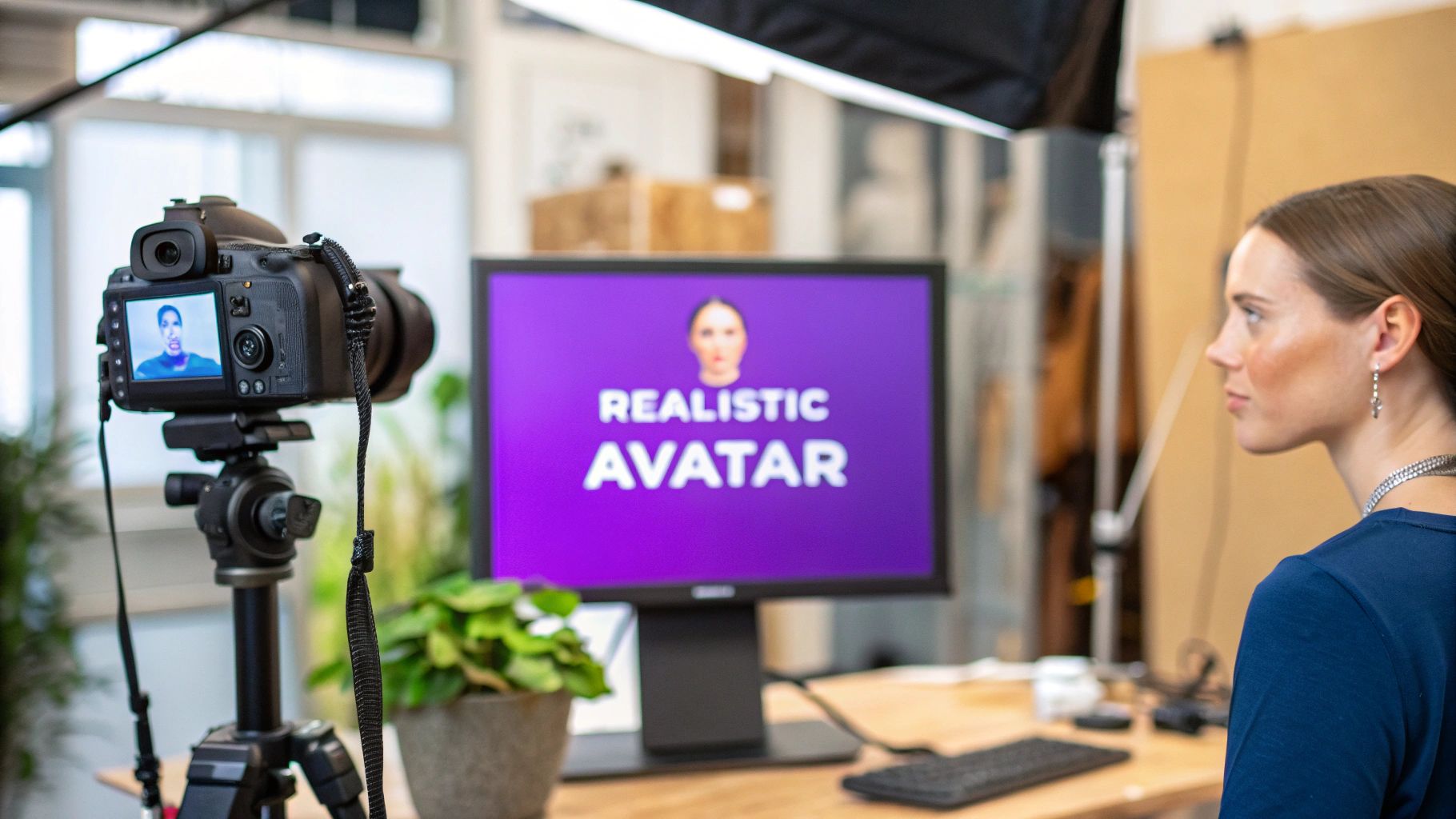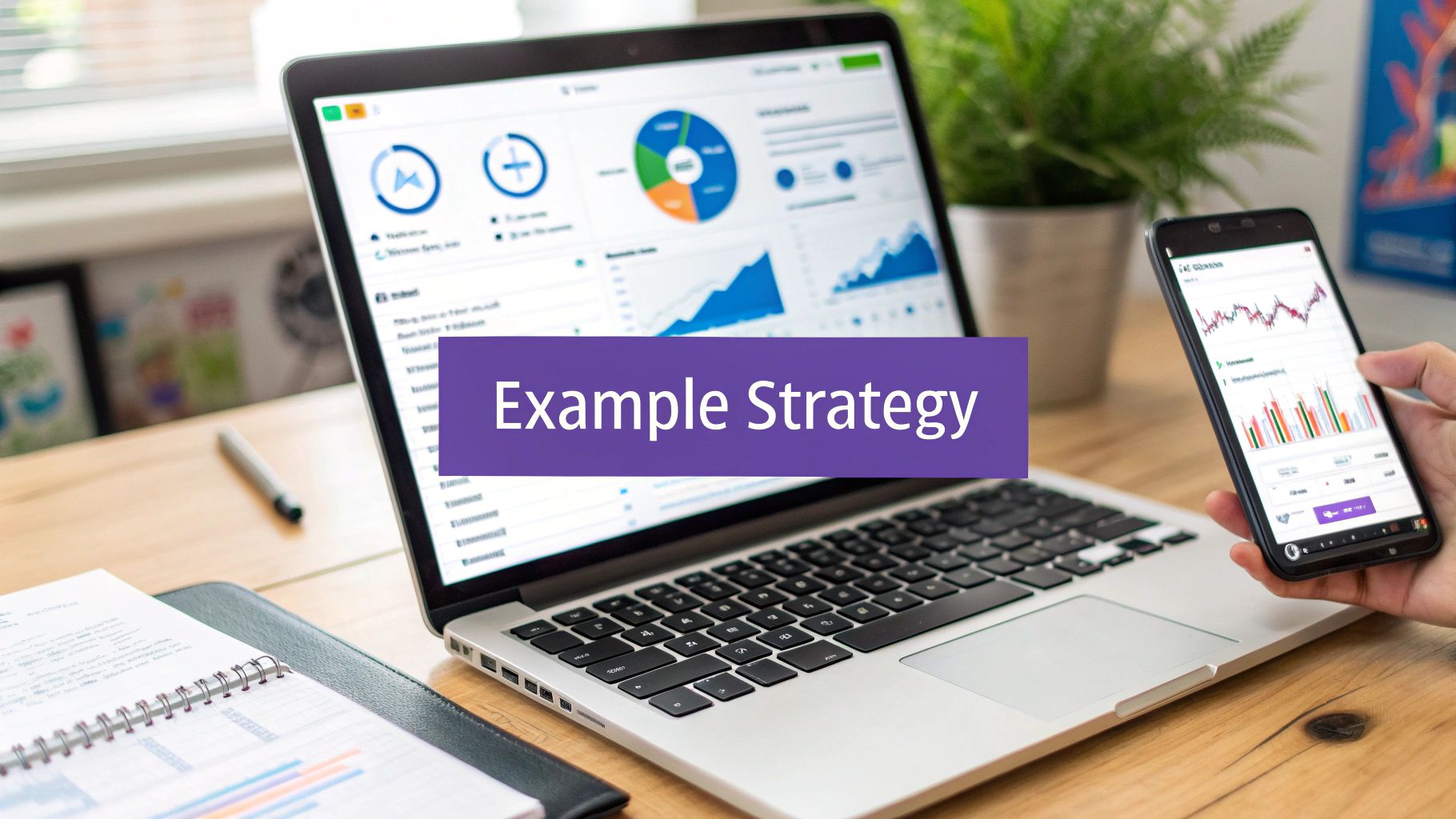Improve Social Media Engagement with Real Tactics
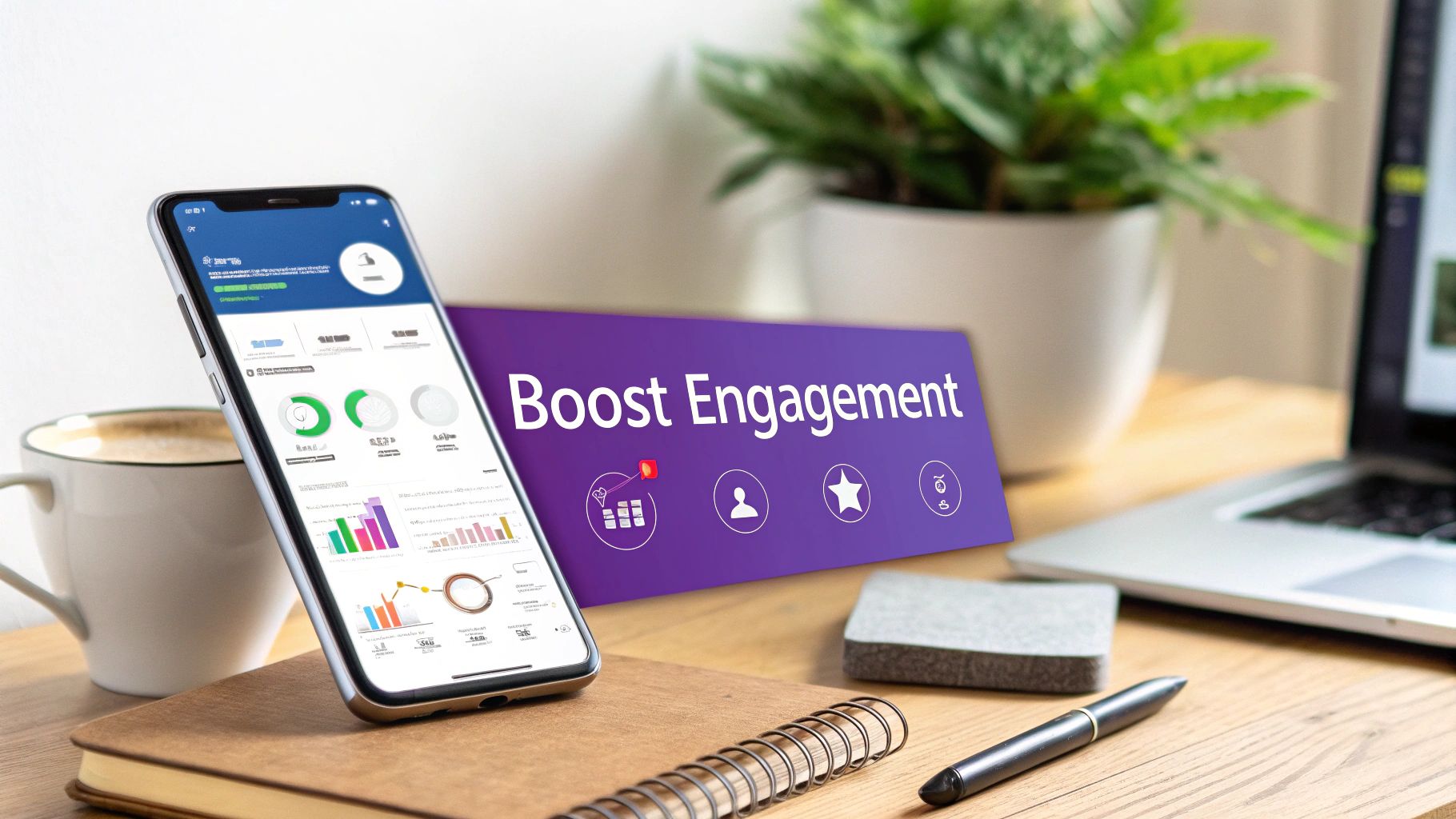
The game has changed. If you're still chasing likes and follows like it's 2015, you're playing an outdated game and you're going to lose. To actually improve social media engagement today, you have to stop broadcasting ads and start building real, authentic connections. Your audience is smarter than ever—they crave meaningful interactions, not just another polished promotion. It's all about community, conversation, and value now.
Why Old Social Media Tactics No Longer Work

Remember when posting three times a day with a handful of generic hashtags was the secret sauce? Those days are long gone. The entire social media environment has shifted under our feet, making a lot of once-effective tactics totally obsolete. Audiences have developed an incredible filter for corporate noise, and platform algorithms have evolved to reward genuine human connection.
What worked yesterday—think simple link drops or cringe-worthy engagement bait—can actually hurt your reach now. People don’t want to be sold to; they want to feel understood, be entertained, and know they're valued. This forces us to get more thoughtful and move beyond surface-level metrics to focus on the actual quality of our interactions.
The Algorithm's Role in This Shift
The algorithms running the show on Instagram, TikTok, and LinkedIn aren't simple chronological feeds anymore. They're incredibly complex systems built to keep users glued to the platform by showing them content that sparks real interest. To keep up, you have to understand how a social media algorithm is explained in today's world: they reward content that starts conversations.
What does that mean in practice? A post with ten thoughtful comments is often way more valuable than one with 100 passive likes. The platforms are actively searching for signals that you're building a community. They're looking for things like:
- Shares and Saves: These are huge indicators. They signal that your content is valuable enough for someone to come back to or pass along to a friend.
- Comment Quality: Deep, conversational replies are weighted much more heavily than a simple "great post!" or a fire emoji.
- Time Spent on Post: The longer someone pauses their scroll to look at your content, the more the algorithm assumes it’s compelling stuff.
The core idea is simple: Social media platforms want to keep users on their app. They do that by pushing content people actually want to interact with, not just scroll past.
Moving Beyond Vanity Metrics
Don't fall into the trap of focusing only on follower counts and likes. These are vanity metrics. They look impressive on the surface, but they rarely translate into real business outcomes. Honestly, a huge but unengaged audience is far less valuable than a smaller, tight-knit community that hangs on your every word.
The real goal today is to build relationships. When you create content that solves problems, sparks discussions, and shows off your brand’s actual personality, you attract an audience that’s genuinely invested in what you do. For a deep dive, this strategic guide on how to increase social media engagement is packed with insights on how to make this happen.
At the end of the day, meaningful engagement is the new currency of social media. It’s what turns passive followers into loyal advocates who drive real, sustainable growth.
Discovering What Your Audience Actually Wants
The secret to killer social media engagement isn't a magic hashtag or a perfect posting time. It's about knowing your audience so well that your content feels like it was created just for them. This means you have to go beyond the basics like age and location and get into psychographics—the real-deal motivations, problems, and passions that drive every single click, comment, and share.
Honestly, truly understanding your audience is the bedrock of any solid social strategy. If you skip this part, you're just throwing content at a wall and hoping something sticks. But when you know what they struggle with, what gets them excited, and what they secretly wish someone would talk about, you can create stuff that's impossible to ignore.
Go Beyond Surface-Level Data
It’s so easy to get hung up on follower counts and age brackets. While that stuff is useful, it doesn't tell you why people follow you. To actually improve your engagement in a meaningful way, you need to dig into the human element behind all those analytics.
A good place to start is by asking better questions. Instead of just knowing your audience is "25-34 years old," find out:
- What are their biggest professional or personal challenges right now?
- What kind of content are they saving for later? Is it tutorials, inspirational quotes, or nitty-gritty industry news?
- What language do they use? Pay close attention to the slang, acronyms, and general tone in their comments and posts.
- Who else do they follow and admire in your space? Sizing up these accounts can reveal content gaps you’re perfectly positioned to fill.
Getting these answers takes a bit of detective work. Our guide on how to identify your target audience is a great starting point for digging into these specifics.
The goal here is to build an audience persona that feels like a real person. Give them a name, a job, and a list of problems. When you start creating content for "Creative Carla" instead of "F, 25-34," your message becomes infinitely more focused and powerful.
Practical Methods for Uncovering Insights
Guesswork has no place in a serious content strategy. The good news is your audience is constantly telling you what they want—you just have to know where to look and listen. These methods will help you pull actionable intelligence directly from the source.
Analyze Comment Threads for Gold
Your comment section is an absolute goldmine. Don't just glance at the number of comments; read what people are actually saying. Look for recurring questions, common frustrations, or even compliments that tell you what really hit home. If five different people ask the same question on a post, that's a massive clue for your next piece of content.
Use Social Listening to Tap In
Social listening is all about monitoring conversations happening across different platforms, not just on your own posts. You can use tools or even simple keyword searches to track mentions of your brand, your competitors, and key topics in your industry. This helps you understand the bigger picture of your audience's world and jump into conversations where it makes sense.
Run Polls That Reveal Preferences
Polls and question stickers, especially on platforms like Instagram Stories, are fantastic for getting direct feedback. But don't just ask fun, fluffy questions. Use them strategically to see if your content ideas have legs. For example, instead of "Coffee or Tea?", ask "Which topic should we cover next? A) X or B) Y?". This gives your audience a real say in what you create.
Understanding the Why Behind the Scroll
It's also crucial to understand why people are even on social media in the first place. The motivations are more complex than you might think. Global data shows that while “keeping in touch with friends and family” is still the top reason (cited by 50.8% of users), people have plenty of other goals.
Nearly half are looking to “fill spare time” (36.8%) or “read news” (over 35%). Engagement is also tied to customer service, with Facebook being a huge channel for support. You can dive deeper into these insights in the global state of digital report from We Are Social. This just goes to show that your content isn't just competing with others in your niche—it's competing for attention against a whole universe of different user intentions.
Choosing Platforms and Content That Actually Fit
Trying to be everywhere on social media is a fast track to burnout, not better engagement. The real secret to boosting engagement is to stop shouting into the void and start having meaningful conversations where your audience actually hangs out. It all comes down to making smart, deliberate choices about where you spend your energy.
Every platform has its own culture, its own language, and its own set of unwritten rules. What absolutely crushes it on TikTok will fall completely flat on LinkedIn. Treating them all the same is a huge mistake. Your first job is to figure out where your ideal audience spends their time, then commit to speaking their language.
Align Your Brand with Platform Culture
Before you even think about posting, you need to get a feel for how each platform works. Think of it like walking into different rooms at a party—the vibe in the kitchen is way different from the one on the dance floor. You wouldn't launch into a long, detailed business story in a room full of people sharing quick, funny anecdotes, right?
This is all about understanding what drives your audience.
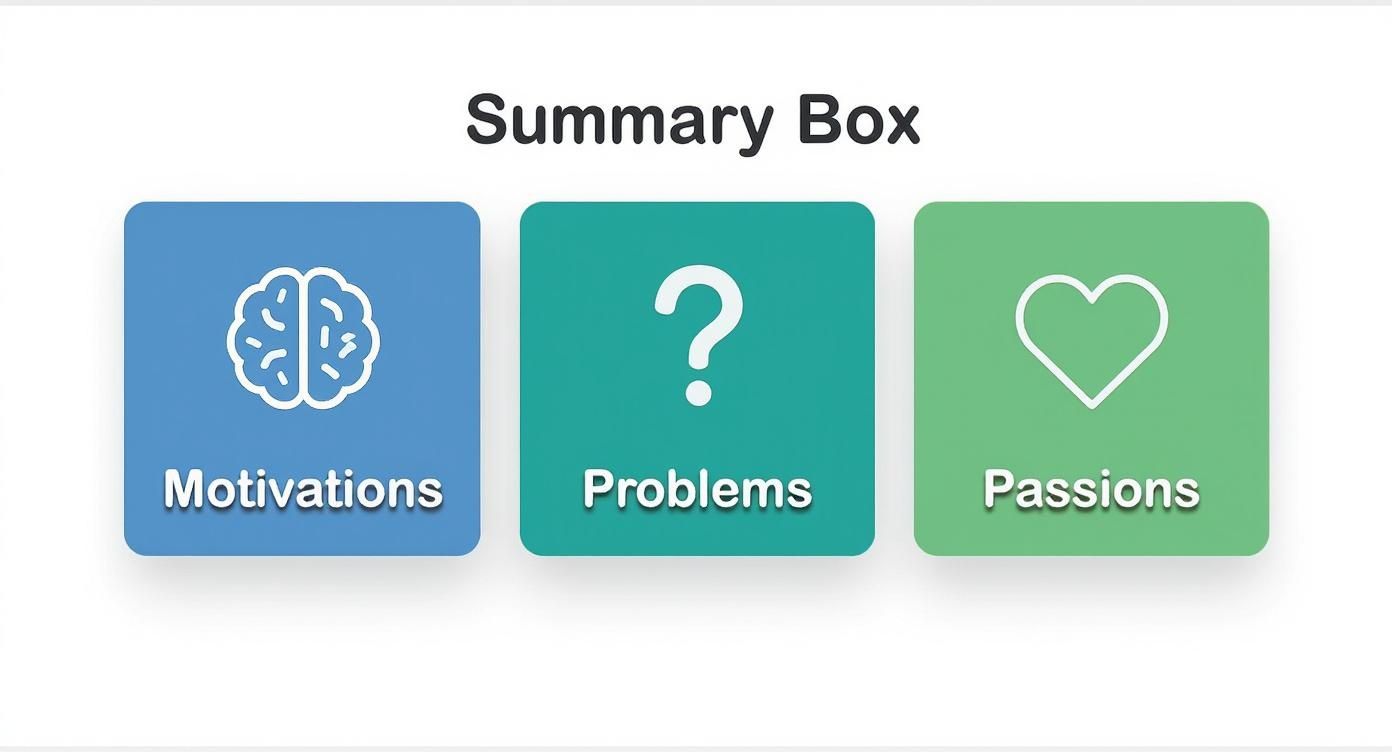
As the visual shows, great content taps into your audience's core motivations, solves their biggest problems, or connects with their deepest passions. Choosing the right platform means finding the one where your brand’s message naturally clicks with what users are there to do.
Things are always changing. While Facebook is still a giant with over 3 billion monthly active users, younger audiences (under 24) are spending less time there. Meanwhile, platforms like TikTok, Snapchat, and Threads are seeing huge jumps in daily use. Video continues to dominate, and with 80% of engagement happening on mobile, your content has to be designed for the small screen. You can find more details about these changing social media demographics on sproutsocial.com.
The biggest mistake I see brands make is copy-pasting the exact same content across every channel without any tweaks. A polished corporate video might do well on LinkedIn, but it will get scrolled past in a heartbeat on TikTok, where raw, authentic clips are king.
Create Platform-Native Content That Clicks
Once you’ve picked your platforms, the goal is to create platform-native content. This just means designing content that feels like it belongs there. It respects the format, tone, and unwritten rules of the community.
Here’s what that looks like in the real world:
- LinkedIn: This is where you bring the value. Focus on insightful, text-based posts, share deep industry analysis, or offer detailed career advice. Well-written, thoughtful threads often perform way better than flashy images.
- Instagram: It's a visual-first universe. High-quality photos, aesthetically pleasing Reels, and interactive Stories are your best friends here. The caption supports the visual, not the other way around.
- TikTok: Think short, snappy, and entertaining. Authenticity, humor, and educational "hacks" perform incredibly well. Don't stress about production quality; a creative idea is what matters most.
- Threads: This platform is all about witty, text-based updates and joining real-time conversations. It’s the perfect spot for quick thoughts, jumping on trends, and having a direct back-and-forth with your followers.
Making content that feels native is a non-negotiable part of a solid social media presence. To learn more about putting a plan in place, check out our guide on what is a social media strategy.
Platform Engagement Strategy Matrix
Don't let FOMO (fear of missing out) drive your decisions. It’s far better to be a big deal on one or two channels where your audience is active than to have a weak, neglected presence on five.
To help you make a strategic choice, I've put together a quick comparison guide. This matrix breaks down which platform might be the best fit based on your audience and the type of content you want to create.
| Platform | Primary Audience | Best For | Top Content Formats |
|---|---|---|---|
| B2B professionals, industry leaders, job seekers. | Thought leadership, professional networking, B2B marketing. | Text-based posts, articles, carousels, professional video. | |
| Gen Z, Millennials, B2C consumers. | Visual storytelling, e-commerce, brand building. | High-quality Reels, Stories, carousels, aesthetic photos. | |
| TikTok | Gen Z, younger Millennials. | Creative expression, viral trends, short-form entertainment. | Short-form videos, tutorials, challenges, humorous clips. |
| Threads | Community builders, brands focused on conversation. | Real-time updates, community engagement, witty commentary. | Text posts, polls, memes, interactive replies. |
By focusing your time and resources on the platforms and formats that actually fit your brand and audience, you stop wasting effort. This strategic focus is what separates content that just gets seen from content that gets a reaction—driving the meaningful engagement you're really after.
Crafting Content That Starts a Conversation
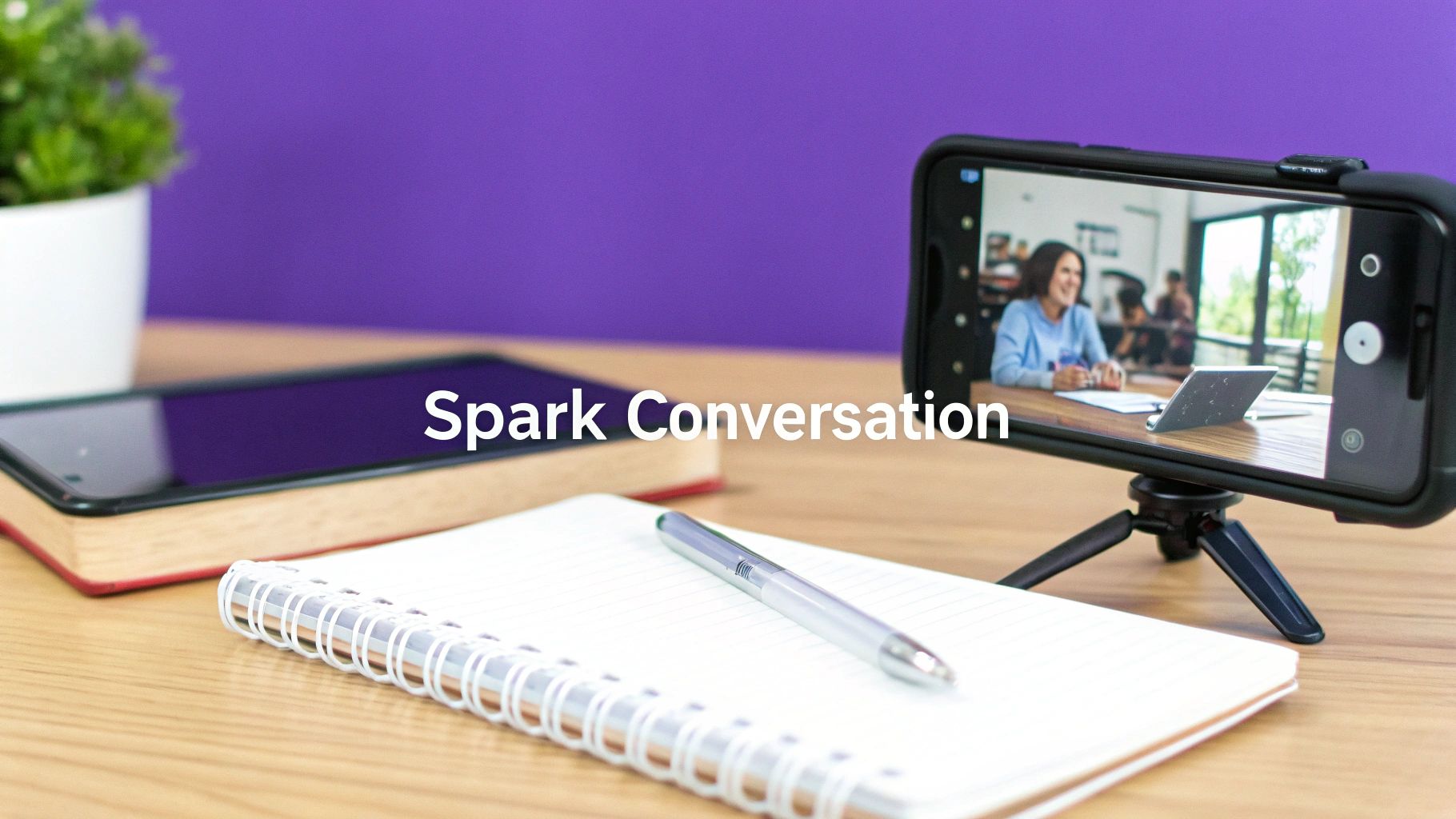
Great content isn't just about getting views—it’s about getting a reaction. It sparks comments, inspires shares, and gets people sliding into your DMs. If you really want to boost your social media engagement, you have to stop just tacking a question onto the end of your captions and start thinking like a conversation architect.
Your real goal? Create posts that are impossible to just scroll past.
This means digging into the psychology of what makes people want to interact. It's about hitting on emotions like curiosity, humor, or that feeling of belonging. The content itself needs to feel like the start of a discussion, not just another broadcast into the void.
Hook Them in the First Three Seconds
Let's be real: attention spans are microscopic. If your video or image doesn't grab someone right away, they're gone. The first three seconds are your entire sales pitch to get them to stop scrolling, making a bold hook non-negotiable, especially for video on platforms like TikTok and Instagram Reels.
Try some of these powerful hook strategies I've seen work time and time again:
- Start with a controversial statement: "Most of the productivity advice you hear is a complete lie." This makes people stop and think, "Wait, what?" They need to know why.
- Pose a relatable problem: "You're applying for jobs but never hear back. Here’s the real reason." This speaks directly to a common pain point and promises a solution.
- Create visual intrigue: Kick off a video with a strange or unexpected action before any text or voiceover appears. The visual mystery alone can be enough to keep them watching.
That initial moment is your most valuable real estate online. Wasting it on a slow intro or a generic logo is a surefire way to kill your engagement before it even has a chance.
Make Your Audience the Hero with UGC
One of the best ways to get a conversation going is to put your audience front and center. User-generated content (UGC) campaigns are perfect for this because they turn your passive followers into active participants. Suddenly, you’re not just talking at them—you're building something with them.
A truly great UGC campaign does more than just ask for photos with a hashtag. It gives your audience a clear, creative mission that makes them feel like part of an exclusive club. For example, a coffee brand could launch a "#MyMorningMug" campaign, asking people to share their unique morning rituals. The brand can then feature the best submissions, giving credit and making those users feel seen. That's how you build a real community.
User-generated content is incredibly powerful social proof. Research shows that 86% of consumers are more likely to trust a brand that features UGC. It’s simple: seeing real people love what you do is way more convincing than any ad you could ever run.
Use Storytelling to Make Your Message Stick
Facts and figures have their place, but stories are what people actually remember. A well-told story can wrap your key message in an emotional package that really connects with your audience. And it doesn't have to be a long, drawn-out saga; even a simple caption can tell a compelling story.
To create content that sparks genuine conversations, mastering your social media content strategy is absolutely fundamental. Instead of just listing a product's features, share a story about a customer whose problem it solved. Instead of just stating a business principle, tell the story of a mistake you made and what you learned from it.
This approach makes your brand feel more human and relatable. People connect with vulnerability and shared experiences, which makes them far more likely to jump into the comments with their own stories. For a deeper dive, check out our guide on how to create engaging content that tells a story.
Turning Followers Into a Thriving Community
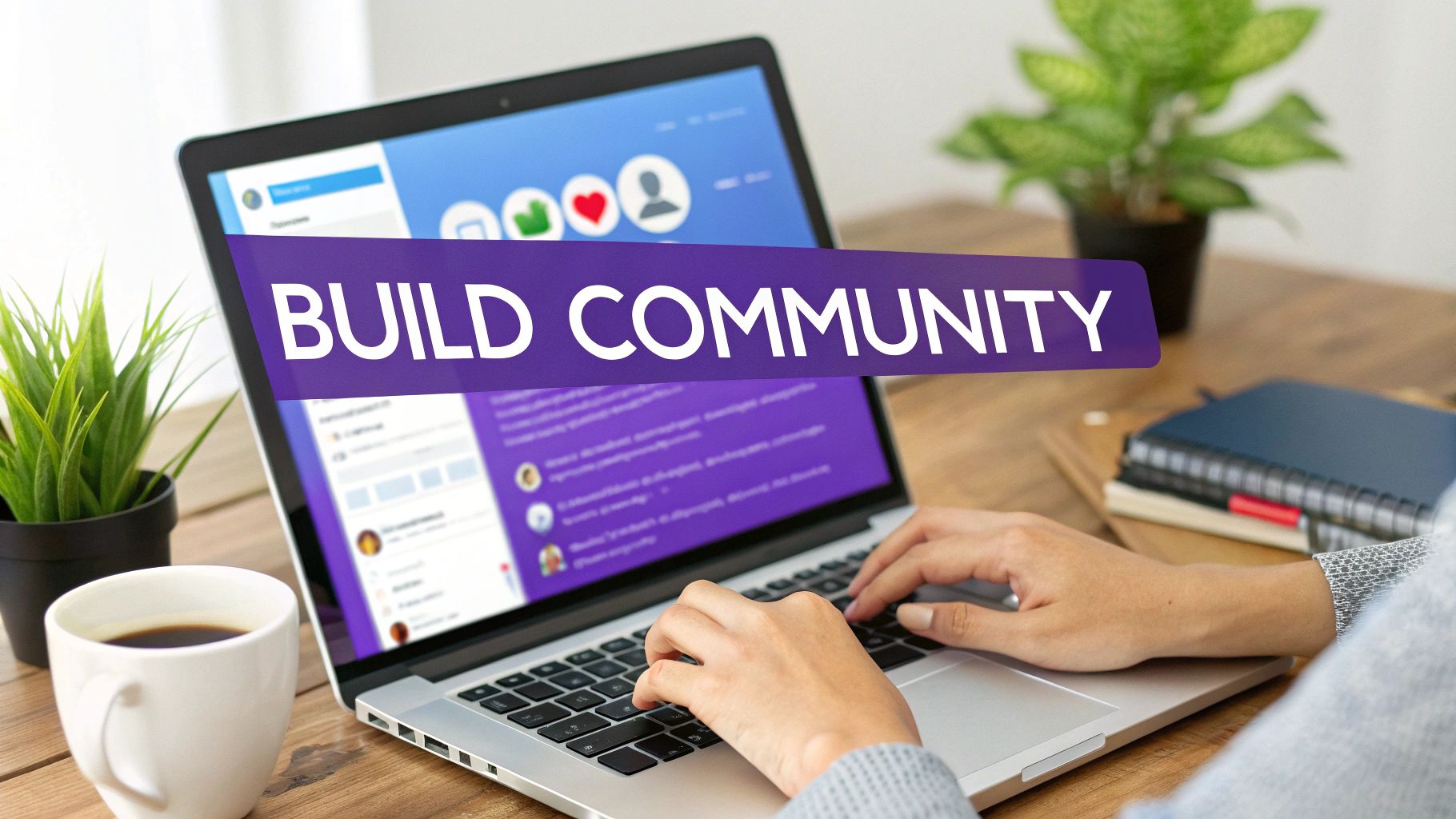
Here’s a hard truth: the real work begins the moment you hit ‘publish.’ A flashy post might get a quick like, but that’s just the start. True, lasting connection is built in the replies, the DMs, and the ongoing conversations that follow.
This is the art of community management. It’s where you shift from just broadcasting content to actively building a space where people feel seen, heard, and genuinely valued. When you get this right, you don’t just have followers—you have advocates who feel a real sense of belonging.
Go Beyond Basic Replies
Replying to comments is table stakes, but the quality of those replies makes all the difference. Generic responses like "Thanks!" or "Great point!" are better than silence, but they’re conversation killers.
The real goal is to keep the ball rolling. Treat every comment as an opening. Ask a follow-up question, offer a related tip, or tag another user who might find the comment interesting. This simple shift shows you’re not just checking a box; you’re an active participant in the discussion you started.
When you reply to comments, ask follow-up questions, and like user comments, you're signaling that there's a real person behind the screen who cares about what they have to say. That feeling is what builds loyalty.
Proactive Strategies to Make Your Audience Feel Seen
Great community management isn’t just reactive. It’s about proactively looking for ways to put your audience in the spotlight. This creates a powerful sense of ownership that no automated post could ever replicate.
Here are a few practical ways to do this:
- Highlight Great Comments: See an insightful comment or a great question? Screenshot it and feature it in your Instagram Stories or even as a standalone post. Give the user a shoutout to publicly thank them for their contribution. It’s a small gesture that makes a huge impact.
- Host Exclusive Q&As: Use features like Instagram Stories or LinkedIn Live to host "Ask Me Anything" (AMA) sessions. This gives your audience direct access and makes them feel like insiders with a direct line to you.
- Create an Inner Circle: You can use features like Instagram's 'Close Friends' list to share behind-the-scenes content or early announcements with your most engaged followers. This simple act creates a powerful feeling of exclusivity and rewards their loyalty.
Navigating Negative Feedback with Grace
Not every interaction is going to be positive, and that’s perfectly fine. In fact, how you handle public criticism says more about your brand than a hundred glowing comments ever could.
The worst thing you can do is get defensive or delete negative comments. That’s a surefire way to lose trust.
Instead, see tricky feedback as a chance to show you’re listening. Acknowledge the person's frustration, thank them for their input, and, if it makes sense, offer to move the conversation to a private channel like DMs to resolve it personally. This approach not only diffuses tension but also shows everyone else watching that you handle challenges with transparency and respect.
If you can't measure it, you can't improve it. A successful social media strategy isn't about being busier; it's about being smarter. This means looking past the ego boost of vanity metrics and honing in on the numbers that signal real, healthy engagement.
Forget fixating on follower counts. Instead, track metrics that tell a story about how your audience truly feels about your content. These are the numbers that show you're not just being seen, but that you're actually making an impact.
Moving Beyond Surface-Level Metrics
To actually move the needle on engagement, you need to get comfortable with the data that matters. It’s a simple shift from focusing on passive indicators to active ones.
Here are the metrics that signal a thriving, engaged community:
- Share Velocity: How quickly are your posts being shared after you publish them? A high velocity is a fantastic sign that your content is striking a nerve and has viral potential.
- Comment Sentiment: Are the comments just fire emojis, or are people asking thoughtful questions and starting real discussions? Positive, conversational sentiment is a much stronger signal than a high volume of generic replies.
- Website Clicks: How many people are interested enough to leave the social platform and visit your site? This is a huge indicator of genuine interest and shows your call-to-action is working.
The ultimate goal is to understand the why behind the numbers. A single, thoughtful comment that sparks a conversation is often more valuable than 100 passive likes.
Running Audits to Pinpoint What Works
Don't just post and pray. Regularly auditing your content is the only way to truly understand what resonates with your audience and what falls completely flat. A simple content audit doesn't have to be some complex, drawn-out process.
Once a month, just pull up your top-performing and worst-performing posts. Ask yourself what’s different. Is it the format? The topic? The tone of voice? This process gives you a clear roadmap for what to create next. For a complete guide on this, check out this data-first approach on how to measure social media success.
Using A/B Testing for Continuous Growth
Guesswork is the enemy of growth. A/B testing, or split testing, is a straightforward way to let data—not your gut—drive your decisions. The idea is to test just one variable at a time to see what your specific audience responds to best.
You can test nearly anything, but it’s best to start with the elements that have the biggest impact on performance.
- Test Your Visuals: Post the same caption with two different images or videos. Does a lifestyle photo outperform a sleek graphic?
- Test Your Captions: Use the same visual but try two different hooks or calls-to-action. See which one generates more comments or clicks.
- Test Your Post Times: Publish similar content at different times of the day to find your audience's sweet spot for activity.
By consistently testing and analyzing, you stop guessing and start building a repeatable formula for high engagement. This is how you create sustainable, long-term growth.
Got Engagement Questions? We've Got Answers
Even with the best strategy in place, you're bound to run into some specific hurdles. Let's tackle some of the most common questions I hear from brands trying to get their social media engagement on the right track. Think of this as your go-to cheat sheet for solving those tricky, real-world problems.
How Often Should I Be Posting, Really?
There’s no magic number here. The golden rule is simple: quality beats quantity every single time.
For platforms like Instagram or LinkedIn, where content has a longer shelf life, aiming for 3-5 high-value posts a week is a great target. But on faster-moving, conversational channels like X (formerly Twitter) or Threads, you can post more frequently—as long as you’re consistently adding to the conversation, not just making noise.
My advice? Start with a schedule you know you can stick to. Then, keep a close eye on your analytics. If you see a dip in reach or interaction, it might be time to pull back and reassess. Consistency is way more important than sheer volume.
What Are the Best Free Tools to Get Started?
Before you even think about spending a dollar, you need to master the free analytics tools baked into each platform. They're surprisingly powerful.
Meta Business Suite for Facebook and Instagram, for example, is a goldmine. It gives you deep insights into who you're reaching, your engagement rates, and detailed audience demographics. LinkedIn Analytics does the same for your company page.
Honestly, the data these platforms give you for free is often more than enough to build a killer strategy. Get comfortable reading and interpreting these native analytics first. They provide the most direct, unfiltered feedback on what’s working and what isn’t.
Help! My Engagement Suddenly Tanked. What Do I Do?
First off, don't panic. It happens to everyone. The first thing I always do is check for recent algorithm updates for that specific platform. A small tweak on their end can completely change what kind of content gets seen.
Next, take a hard look at your last 10-15 posts. Did you switch up your format, your topics, or your tone of voice? Sometimes a single post that feels "off-brand" can throw off your momentum and leave your audience scratching their heads.
If you’re still stuck, try going back to basics. Revisit a content format or topic that you know has performed well in the past to see if you can get the conversation going again. And if all else fails? Just ask. A simple poll or question asking your audience what they want to see is often the quickest way to get back on track. Their feedback is always your best compass.
Ready to stop guessing and start growing? MakerBox uses AI to instantly generate optimized bios, profile pictures, and content that gets you noticed. Transform your professional presence in 30 seconds. Elevate your profile with MakerBox today.


